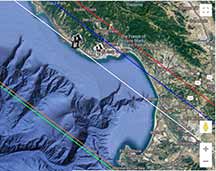


This high rank event skims the coast from Santa Cruz north to Davenport, and otherwise needs to be tried from south of Moss Landing. We're hoping for fog-free conditions, in which case I plan to try it from Coast Rd 7 miles north of Santa Cruz. Kirk will probably try from home. It's 32 degrees up at Azimuth 281 in Gemini. The odds of a hit from Karl's in the SC . mountains is small. However, we're all 3 trying it. Kirk from home.
 |
 |
 |
Good success. Karl, Kirk, and I all got successful tapings. Kirk and I had ~1 sec events, and Karl, as the path suggested, got a miss.
Richard Nolthenius (PyOTE log file)
I observed from as deep into the path as I could conveniently get and still be in Santa Cruz County; I drove up Hwy 1 to Coast Road, and set up on the north intersection of Coast Rd and Hwy 1, a bit awkwardly in the road to avoid power lines. Skies are excellent and I got a good taping at a high time resolution using 2x.
|
PyMovie 3.7.3 screen |
I used 2 tracking stars (blue, yellow), the target (green), and the sky (red) |
It didn't really change the solution, but I did decide to use the Tracking2 star as a reference star, with period = 16 smoothed. |
PyMovie's raw data for the target. I did not use integration, instead using 2x (1 frame per integration), |
Zoomed in on the 1.2 second occultation. We were near the northern limit, with predicted full diamter occultation of 3.1 seconds, so there may be some gradual'ness in the D and R because of the near grazing incident angle |
|
The historgram is solid zero-chance of a false positive |
The PyOTE solution, zoomed in. The D and R times have quite good timings. I've had good luck using 2x for 11th magnitude stars and getting highly precise D and R times. |
KIrk Bender (PyOTE log file)
Observed from home. Got a 0.8 second occultation, and was closer to the northern limit than I was, on this steeply slanting shadow path
Got a clear positive. I started the recording in time, but I noticed a bright star was drifting into my time stamps and I was afraid it would mess up the OCR, so I stopped, re-centered, and started again, and the event occurred shortly after starting the recording. The beginning of my second recording has a scope bump in it so I trimmed that out in PyOTE. Easily passed false positive. Event was a little earlier than predicted, that is the predicted time was close to the R, rather than between the D and R.
magDrop report: percentDrop: 97.6 magDrop: 4.030 too much noise; cannot calculate error bars snr: 4.31 D time: [06:29:57.6067] D: 0.6800 containment intervals: {+/- 0.0176} seconds D: 0.9500 containment intervals: {+/- 0.0442} seconds D: 0.9973 containment intervals: {+/- 0.0911} seconds R time: [06:29:58.0739] R: 0.6800 containment intervals: {+/- 0.0176} seconds R: 0.9500 containment intervals: {+/- 0.0442} seconds R: 0.9973 containment intervals: {+/- 0.0911} seconds Duration (R - D): 0.4672 seconds Duration: 0.6800 containment intervals: {+/- 0.0269} seconds Duration: 0.9500 containment intervals: {+/- 0.0613} seconds Duration: 0.9973 containment intervals: {+/- 0.1209} seconds
 |
 |
 |